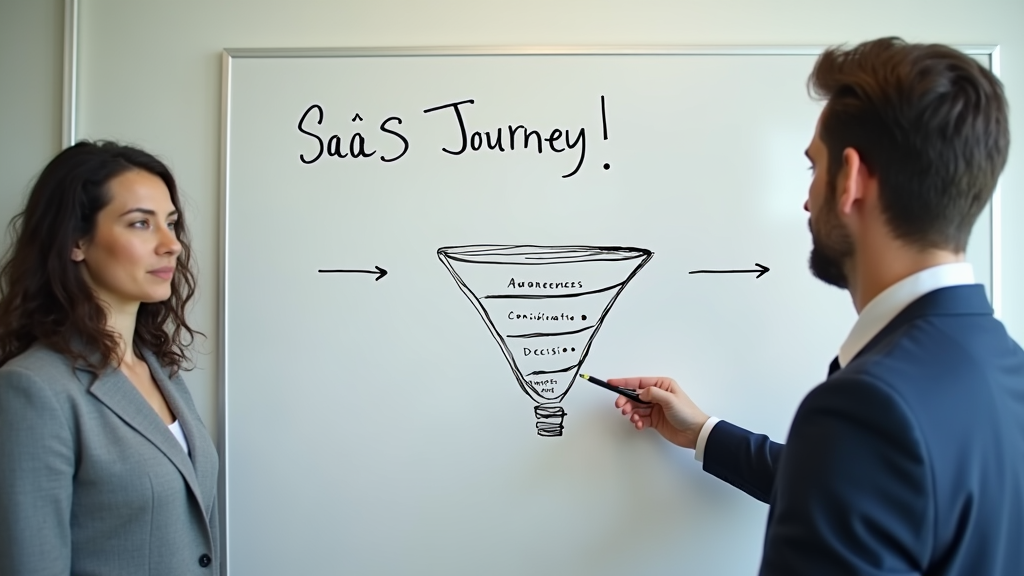
In the fast-moving world of Software as a Service (SaaS), staying ahead of the competition requires constant evaluation and improvement of your marketing strategies. A SaaS marketing audit is a powerful tool that can help you identify strengths, weaknesses, and opportunities in your current approach. This guide will walk you through the process of conducting a thorough SaaS marketing audit, providing you with actionable insights to boost your marketing performance.
Understanding SaaS Marketing Audits
What is a SaaS Marketing Audit?
A SaaS marketing audit is a comprehensive review of your company's marketing efforts. It involves analyzing various aspects of your marketing strategy, from your digital presence to your lead generation tactics. The goal is to gain a clear picture of what's working, what's not, and where there's room for improvement.
Conducting regular audits is crucial for SaaS companies. The digital marketing landscape changes rapidly, and what worked yesterday might not be as effective today. By performing audits, you can stay on top of these changes and adapt your strategies accordingly.
Why are Regular Audits Important?
Regular audits offer several benefits for SaaS companies. First, they help improve your return on investment (ROI) by identifying which marketing channels and campaigns are delivering the best results. This information allows you to allocate your resources more effectively, focusing on the strategies that drive the most growth.
Second, audits can enhance your customer acquisition and retention efforts. By analyzing your current customer base and acquisition channels, you can refine your targeting and messaging to attract more of your ideal customers. Additionally, understanding why customers stay with your service can help you improve retention strategies.
When Should You Conduct an Audit?
While there's no one-size-fits-all answer, most SaaS companies benefit from conducting marketing audits quarterly or bi-annually. This frequency allows you to track progress and make adjustments without getting bogged down in constant analysis.
However, certain situations may call for an audit outside of your regular schedule. For example, if you're planning a major strategy shift or if there have been significant changes in your market, an audit can provide valuable insights to guide your decisions.
Key Components of a SaaS Marketing Audit
Marketing Strategy Assessment
The first step in any SaaS marketing audit is to review your overall marketing strategy. This involves examining your value proposition, target audience, and competitive landscape.
Start by revisiting your value proposition. Is it still relevant and compelling to your target market? Does it clearly communicate the unique benefits of your software? If not, it may be time for a refresh.
Next, analyze your target audience. Have their needs or preferences changed? Are there new segments you should be targeting? Use tools like Google Analytics to gather demographic and behavioral data about your website visitors and customers.
Finally, evaluate your competitive landscape. Identify your main competitors and analyze their marketing strategies. Look for gaps in the market that you could fill or areas where you can differentiate your offering.
Digital Presence Evaluation
In the SaaS industry, your digital presence is often the first point of contact with potential customers. Therefore, a thorough evaluation of your online presence is crucial.
Start with a website audit. Analyze your site's design, user experience, and content. Is your messaging clear and consistent? Is your site easy to navigate? Does it load quickly on both desktop and mobile devices?
Next, assess your SEO performance. Use tools like SEMrush or Ahrefs to analyze your keyword rankings, backlink profile, and on-page optimization. Identify areas where you can improve your search engine visibility.
Finally, evaluate your content marketing efforts. Are you consistently producing high-quality, relevant content that addresses your audience's needs and pain points? Analyze the performance of your blog posts, whitepapers, and other content assets to identify what resonates most with your audience.
Lead Generation and Nurturing
Lead generation and nurturing are critical components of any SaaS marketing strategy. Your audit should include a thorough analysis of these processes.
Start by identifying your main lead sources. Which channels are driving the most qualified leads? Are there any untapped channels you should explore?
Next, assess your conversion funnel. Analyze each stage of the funnel to identify where leads are dropping off. Are there bottlenecks you can address to improve conversion rates?
Finally, review your marketing automation processes. Are your email nurture sequences effectively moving leads through the funnel? Are you personalizing your communications based on lead behavior and characteristics?

Customer Acquisition and Retention
Understanding your customer acquisition and retention metrics is crucial for sustainable growth in the SaaS industry.
Start by calculating your Customer Acquisition Cost (CAC). This metric helps you understand how much you're spending to acquire each new customer. Compare this to your Customer Lifetime Value (CLV) to ensure you're achieving a healthy ratio.
Next, analyze your churn rate. Are customers staying with your service as long as you'd like? If not, dig deeper to understand why they're leaving and what you can do to improve retention.
Brand Awareness and Positioning
The final component of your SaaS marketing audit should focus on your brand awareness and positioning in the market.
Start by auditing your social media presence. Are you active on the platforms where your target audience spends time? Are your posts generating engagement and driving traffic to your website?
Next, assess your PR and media coverage. Are you getting mentioned in industry publications? Are there opportunities to increase your visibility through thought leadership or speaking engagements?
Finally, conduct a brand sentiment analysis. Use social listening tools to understand how people perceive your brand online. Are there any negative sentiments you need to address?
Steps to Conduct a Comprehensive SaaS Marketing Audit
Now that we've covered the key components, let's walk through the steps to conduct a comprehensive SaaS marketing audit.
1. Define Audit Objectives and Scope
Before diving into the audit, clearly define what you want to achieve. Are you looking to improve lead generation? Reduce customer churn? Increase brand awareness? Setting clear objectives will help you focus your efforts and ensure you gather the most relevant data.
2. Gather Relevant Data and Metrics
Once you've defined your objectives, gather all the necessary data. This may include website analytics, social media metrics, email marketing stats, sales data, and customer feedback. Make sure you have access to all the tools and platforms you need to collect this information.
3. Analyze Marketing Channels and Campaigns
With your data in hand, start analyzing each of your marketing channels and campaigns. Look at both quantitative metrics (like traffic, conversions, and ROI) and qualitative factors (like messaging consistency and brand alignment).
4. Evaluate Marketing Technology Stack
Your marketing technology (martech) stack plays a crucial role in your marketing efforts. Evaluate each tool in your stack. Are you using all the features you're paying for? Are there any gaps in your capabilities that a new tool could fill?
5. Assess Team Structure and Skills
Your marketing team is the engine that drives your marketing efforts. Assess your team structure and individual skill sets. Are there any skill gaps that need to be filled? Could restructuring your team improve efficiency?
6. Review Budget Allocation and ROI
Analyze how you're allocating your marketing budget across different channels and initiatives. Compare the ROI of each to identify where you're getting the best return and where you might need to adjust your spending.
7. Identify Gaps and Opportunities
Based on your analysis, identify any gaps in your current marketing strategy. These could be untapped channels, underserved audience segments, or missed opportunities for personalization. Also, look for opportunities to optimize or expand your current efforts.
8. Develop Actionable Recommendations
Finally, translate your findings into actionable recommendations. Prioritize these based on potential impact and ease of implementation. Create a roadmap for implementing these changes over the next quarter or year.
If your audit reveals opportunities for new product features or services, consider using FastWaitlist to validate these ideas. Creating a waitlist can help gauge interest and build anticipation before you invest significant resources in development.
Tools and Resources for SaaS Marketing Audits
Conducting a thorough SaaS marketing audit requires the right tools. Here are some essential resources to consider:
Analytics Platforms
- Google Analytics: Essential for tracking website traffic and user behavior.
- Mixpanel: Offers advanced user analytics and funnel tracking.
- Amplitude: Provides detailed product analytics and user journey mapping.
SEO and Content Analysis Tools
- SEMrush: Comprehensive SEO and content marketing toolkit.
- Ahrefs: Powerful for backlink analysis and keyword research.
- Moz: Offers a suite of SEO tools and resources.
Social Media Monitoring Tools
- Hootsuite: Manages multiple social media accounts and provides analytics.
- Sprout Social: Offers social media management and deep analytics.
- Buffer: Simplifies social media scheduling and provides basic analytics.
Customer Feedback and Survey Tools
- SurveyMonkey: Creates and distributes surveys to gather customer feedback.
- Typeform: Builds engaging surveys and forms.
- Qualtrics: Provides advanced survey and experience management tools.
Best Practices for Implementing Audit Findings
Once you've completed your SaaS marketing audit, the real work begins: implementing your findings to improve your marketing performance.
Prioritizing Recommendations
Start by prioritizing your recommendations. One effective way to do this is by using an impact vs. effort matrix. Plot each recommendation on a grid based on its potential impact and the effort required to implement it.
Focus on the "quick wins" first - high-impact, low-effort changes that can deliver immediate results. These might include optimizing high-traffic web pages or tweaking email subject lines to improve open rates.
Next, plan for the "major projects" - high-impact changes that require more significant effort. These could include revamping your content strategy or implementing a new marketing automation system.
Creating an Action Plan
With your priorities set, create a detailed action plan. Assign responsibilities to team members, set clear timelines, and establish milestones to track progress.
Break down larger projects into smaller, manageable tasks. This makes the implementation process less overwhelming and allows you to celebrate small wins along the way.
Monitoring Progress and Adjusting Strategies
Implementation is an ongoing process. Set up regular check-ins to monitor progress and discuss any challenges that arise. Be prepared to adjust your strategies based on early results.
Use data to guide your decisions. If a particular change isn't delivering the expected results, don't be afraid to pivot or try a different approach.
Communicating Findings and Plans to Stakeholders
Effective communication is key to successful implementation. Create executive summaries of your audit findings and action plans for leadership. These should highlight the most important insights and the potential impact of your proposed changes.
For your marketing team, provide more detailed, role-specific action items. Make sure everyone understands how their work contributes to the overall goals.

Remember, FastWaitlist can be a valuable tool for engaging potential customers and growing email lists for new initiatives identified in your audit. It's an effective way to gauge interest and build anticipation for new features or products before fully committing resources to their development.
Conclusion
Conducting a SaaS marketing audit is a powerful way to optimize your marketing efforts and drive growth. By thoroughly examining each aspect of your marketing strategy, you can identify areas for improvement and uncover new opportunities.
Remember, marketing optimization is an ongoing process. Regular audits help you stay agile and responsive to changes in your market and customer needs. Start your audit process today, and you'll be well on your way to more effective, efficient SaaS marketing.
Whether you're looking to refine your current strategies or explore entirely new marketing avenues, a comprehensive audit provides the insights you need to make informed decisions. So, roll up your sleeves, dig into your data, and get ready to take your SaaS marketing to the next level.
